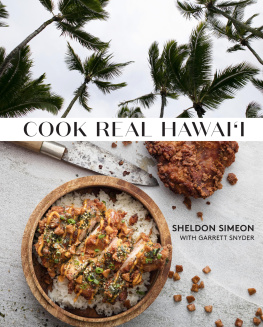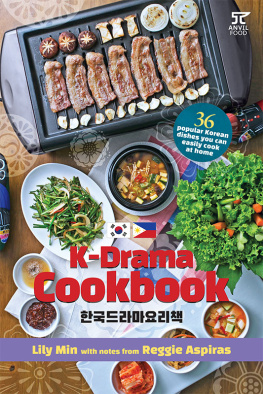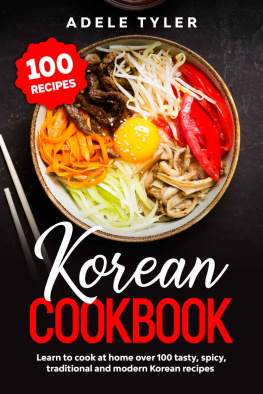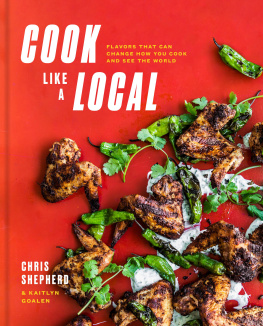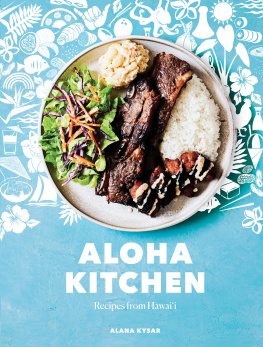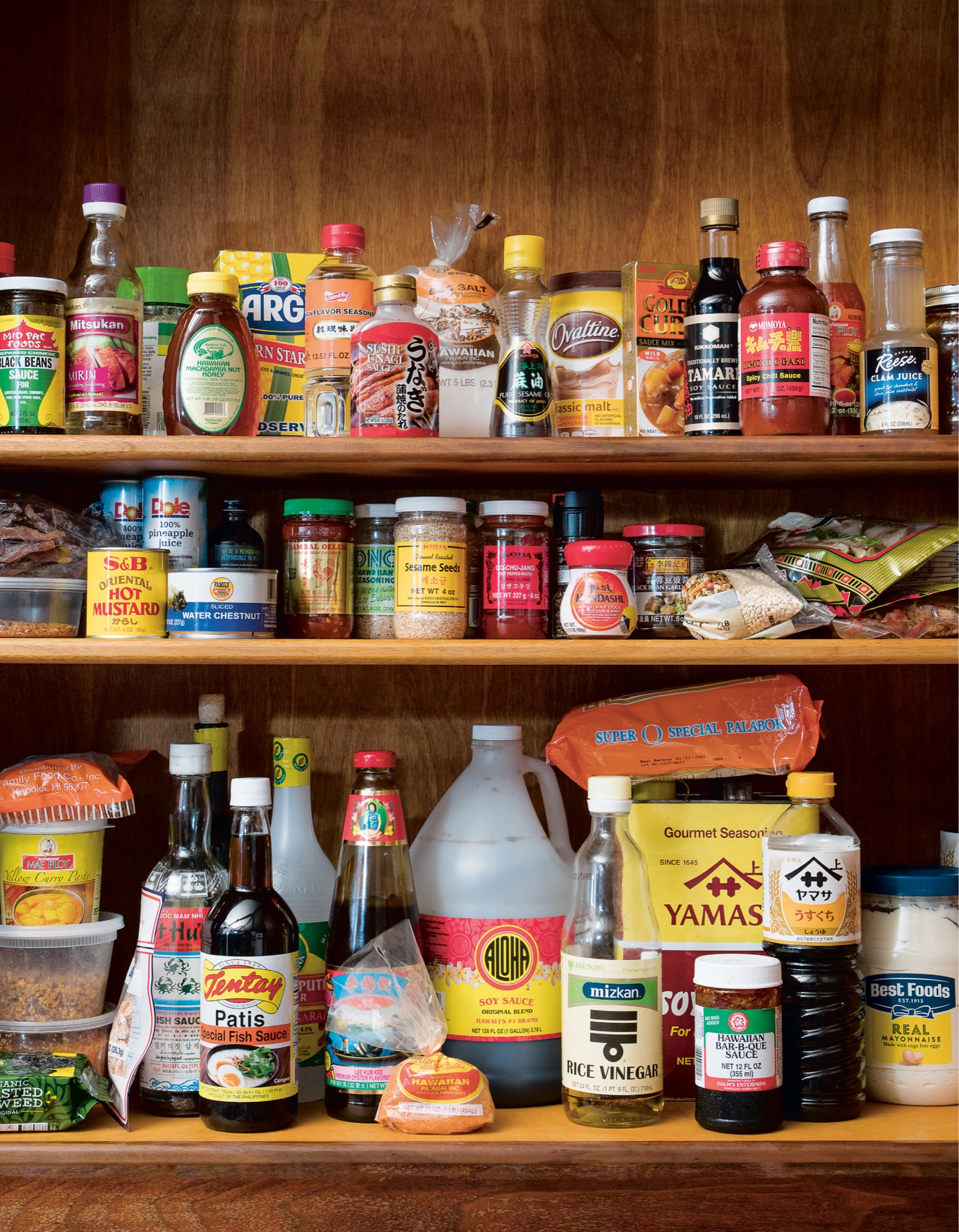Contents
Landmarks
Print Page List
MAHALOS
First and foremost, mahalo to the Lord above for all the blessings in my life. I have so much to be thankful for and I know its because of Your doing.
To my amazing family, Janice, Chloe, Peyton, Quinn, and Asher. Youve had to sacrifice so much, and I love all of you more than words can express. Janice, you are my rock and my biggest critic. Thank you for pushing me and making me a better person. I would never have tried to do this cookbook without your encouragement, and you always, always got my back.
To Mom and Dad, thank you for the life you gave me. Growing up, I always felt like we never had much, but the values and lessons you instilled in me proved to be priceless.
Mom, I miss you every day. Whenever I look at my girls, I see a bit of you smiling back at me.
Dad, with your deep love and respect for food, youve been the biggest influence in my life. I know our stubbornness sometimes gets in the way of our relationship and expressing our feelings, but know that Im so grateful to have someone thats always encouraged and supported me to Just go!
To my brother, Jeremy, given our upbringing, I guess we were destined to become chefs. Thank you for always looking out for me and showing me the way.
To my Simeon ohana, I always look forward to our get-togethers. Our memories of cooking and eating together are the foundation of what my work is all about.
To Nolan, I couldnt ask for a better wingman. Ive seen you grow from a bright-eyed cook into a confident, young chef of your own. Youve been there and had my back for some of the highest highs in my career: nights in the trenches, long hours in the kitchen, laughing in the streets of NYC in the wee hours. The sky is the limit for you.
To Garrett, I dont know if theres another writer out there who would have been able to swallow a culture and digest it the way that you did, with full understanding and respect, writing it through my voice. Im forever grateful.
To Kevin, you were such a pleasure to work with. You fit right in and felt like family. Im so thankful that our paths crossed and you were able to lend your incredible eye to this book.
To Melissa, you went above and beyond in bringing the vibe I imagined to lifeyoure a true master at making things make sense, if that makes sense.
To the Tin Roof crew, you all keep me young with your energy and positivity. Mahalos for being a part of our community, and for keeping the fire alive when I couldnt.
To the Lineage crew, thank you for being patient with me as we brought this project to life. You totally grasped my vision to share the story of Hawaii through food. Your curiosity and dedication is infectious.
To Kitty, thank you for keeping the faith. The idea of a cookbook seemed so far-fetched at first but you made it a reality.
To Nicole and the crew at Bolster Media, you nudged me out of the shadows and into brighter spotlights that have led to more opportunities than this local boy could have ever imagined, all while holding my hand along the way.
To my bruddahs Gooch, Isaac, Kelii, mahalos for reminding me to stay grounded in my Hawaii roots and for doing big things that never cease to motivate me.
To Ryota, you always manage to make us look like we know what were doing. Thank you for sharing your immense talent.
To Hilo, my hometownI can always count on you to set my head straight and provide inspiration, whether its a fresh catch for the grill or wild pig for the smoker, or just a late-night crew to knock back some beers with and reminisce in the Popolo Street garage. Mahalos for the love and support.
And last but not least, mahalos to all the people of Hawaii working to protect the future of our islandswithout you I would have no story to tell.
SHELDON SIMEON lives on Maui and is the chef and owner of Tin Roof, where he serves local Hawaii favorites. His restaurant Lineage was named one of Bon Apptits top 50 new restaurants. Simeon was a finalist and voted Fan Favorite on seasons 10 and 14 of Top Chef.
INGREDIENT GUIDE
Alcohol (not just for drinking!)
Beer
Although there are no recipes in this book where beer is an ingredient, there are many dishes that suggest drinking a cold one on the side. I find a light, crisp lager or pilsner usually pairs best.
Mirin
Mirin is a sweet Japanese cooking wine that is a little lower in alcohol and higher in sugar than sake. Its often used to add a particular mellow-sweet flavor to Japanese sauces, dressings, and marinades.
Sake
The original Japanese rice brew, sake is used in situations where a drier cooking wine is needed. Use a clear sake rather than unfiltered. Dont hesitate to pick the cheapest bottle rather than something meant for sipping.
Shaoxing wine
Shaoxing, sometimes called shao hsing, is a Chinese cooking wine. It tends to be less sweet and more savory than sake. Dry sherry is the best substitute.
Whiskey/brandy
Many locals use brown liquor as a substitute for aged Chinese spirits or an Okinawan spirit called awamori. Use whatever brand you normally drink (in my family its Crown Royal).
Arare (Rice Crackers)
Also called kakimochi (mochi crunch), these soy-glazed rice crackers come in many different sizes, colors, and shapes. A popular snack that can be eaten by themselves, they can also be crushed and used as a topping for rice and vegetables.
Bagong (Fermented Fish Paste)
Sometimes labeled salted fish paste, this funky fermented condiment is a crucial element in Filipino dishes that come from the Ilocos region, where my family is originally from. If you cant find it in an Asian market, you can substitute shrimp paste, which is commonly used in Southeast Asia, mixed with a little fish sauce.
Banana Ketchup
Made with mashed bananas instead of tomatoes, banana ketchup is a popular condiment in the Philippines. Like the regular kind, its sweet, tangy, red, and delicious on anything fried. Look for the Jufran brand in Asian markets.
Black Beans, Salted or Fermented
Chinese fermented or salted black beans are made from black soybeans. They usually come in vacuum-sealed bags or cans, but once opened will last for months in a cool, dark place. Most often salted black beans are used to make black bean sauce for Chinese stir-fries or other dishes. Soak them in hot water until soft, then roughly mash with a fork before using. If unavailable, prepared black bean sauce sold in jars can be substituted.
Broth
When using canned or boxed broth, I prefer to use the low-sodium kind and season with salt later as needed. If you have regular broth, hold back a bit of the salt (or salty seasonings) in the recipe.
Chinese Five-Spice POWDER
This powdered seasoning blend is a classic ingredient in Chinese cooking. Ingredients can vary, but most contain: cinnamon, star anise, cloves, licorice or fennel seed, and white pepper. You can find it in any grocery store.
Chinese Hot Mustard
Sold prepared or in powdered form, this zippy nasal-clearing mustard is a popular condiment in Hawaii, often used in combination with shoyu (soy sauce) as a dip for noodles or sashimi. I prefer the powdered kind because it lasts longer and you can mix it with water to your own taste.
Coconut
This book calls for three kinds of coconut products: coconut milk, shredded coconut, and coconut flakes. Canned coconut milk works great, just be sure to use the unsweetened full-fat kind that has only coconut milk and water as ingredients. Both shredded coconut and coconut flakes should be unsweetened.

